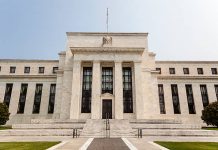Markets
The Fed kept policy rates and its asset purchase programme unchanged. As expected, it provided forward guidance, saying it will buy Treasuries (at least $80bn/month) and mortgage-backed securities ($40bn/month) until substantial further progress has been made toward the Committee’s maximum employment and price stability goals in a statement that is otherwise a copy paste. Chair Powell did not (want to) specify what “substantial” exactly means. Growth forecasts were mostly revised upwardly, showing a smaller decline for 2020 of -2.4% (vs -3.7% in September), a recovery in 2021 by 4.2% (4%), 3.2% in 2022 (3%) and 2.4% in 2023 (2.5%). A new addendum revealed the majority of governors assessed risks to growth now broadly balanced. Unemployment is expected to be several bpn lower across the policy horizon while PCE inflation won’t creep above the average 2% target (2% in 2023). The dot plot thus projects no rate change at least until 2023. Powell sounded more optimistic during the Q&A. He did compensate the lack of immediate stimulus with a vow to step up support if needed. For now however, financial conditions are easy enough, adding that it is the pandemic that is holding back (services) activity, not the financial environment. USTs slipped initially before trimming losses after Powell’s dovish verbal twists to a slightly more hawkish-than-expected assessment. US yields rose less than 1bp across the curve. German Bunds underperformed due to a strong positive surprise from European PMIs of which we keep the continued price building pressures in mind. Yields rose 3-4 bps across the curve. The dollar erased a Fed-induced kneejerk leg higher. EUR/USD finished the session at 1.22, a new big figure explored earlier in the session after the PMIs. USD/JPY remained below 104 (103.47). EUR/GBP traded directionless in the low 0.90 area amid mixed PMIs and awaiting Brexit negotiations.
Asian sentiment is constructive as US Congressional leaders are inching ever closer towards a stimulus deal with possible spill-over effects to the rest of the world. Australia and New Zealand data beat consensus. The USD slips as US real yields continue grinding lower. DXY nears 90! EUR/USD jumped to 1.223. Core bonds trade a tad lower.
Trading today will likely to be inspired by investors mulling the Fed. Powell didn’t sound very concerned with the recent controlled rise in US yields, saying that markets understand the central bank’s policy very well. We assume this protracted uptrend to hold as markets eye the economic recovery while having in mind that the door for future easing (if eg the rate-sensitive sector would worsen early next year) isn’t completely shut. This is evidenced by the ongoing divergence between US inflation expectations and real yields. The dollar remains in dire straits and we see no reason to row against the current tide. We’ll keep a close eye on DXY 90. The Bank of England meets today. We expect a wait-and-see bias after easing last month and the end-of-year Brexit deadline nearing. We’ll watch for any references to negative rates but don’t expect the BoE to signal implementation in the short run. We hold our view that as long as the positive attitude towards an agreement holds, sterling could extend (short term) gains.
News Headlines
New-Zealand’s economy recovered by 14.4 % in the third quarter. This also put GDP 0.4% above the level of the same quarter last year. Q3 growth was stronger than expected and beat the forecast of the Reserve Bank of New Zealand (-1.3% Y/Y). On average, GDP contracted 2.2% in the year up to September. Today’s data support the view that fiscal and monetary support is putting the economy on the path of a V-shaped recovery. New-Zealand 10-y yield is rising 6 bp. The kiwi dollar (NZD/USD 0.7135) extends its uptrend.
Australian employment rose a strong 90k in November. A more moderate rise of about 40k was expected. Other indicators in the report also confirmed an improvement in labour market conditions as the country brought the most recent virus outbreak under control. The unemployment rate declined further to 6.8% from 7.0%. The participation rate rose to 66.1% from 65.8%. AUD/USD (0.7592) is nearing the next big figure.












